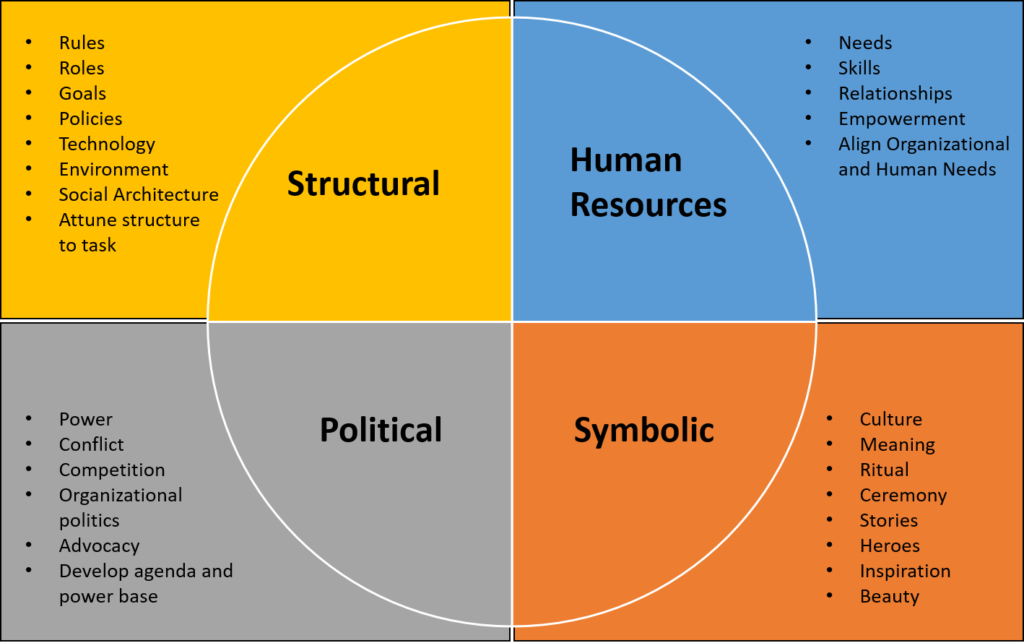Framing refers to the way information is communicated or contextualised by a person (or group of people) to influence the choices others (i.e. the audience) make about how to process that information.
A frame that we hold on any given situation is naturally based on our perspective. This is created from our underlying values, beliefs, assumptions, experiences, personality types, background so it is often communicated unconsciously.
In the context of leadership, framing can be used to help employees understand, define and prioritise difficult business (and personal) obstacles and issues. Reframing the way we communicate can help employees navigate around obstacles. It can enhance the positive impact a leader has on their team as it encourages ‘a more constructive way to view the world, expands your horizons and gain resilience to move ahead even when bad things happen.’
In her book ‘How Remarkable Women Lead‘, Joanna Barsh and colleagues list ‘positive framing’ as one of the five fundamental dimensions of Centred Leadership.
Here are 4 tips to help you become more aware of framing and how to use framing and reframing techniques to help you and your team excel!
Tip #1: Becoming Aware of Your Frame
Pay attention to the language you use and become aware of your frame.
Listen to the way you naturally communicate, particularly listen out for words like:
- I can’t…
- There’s no alternative…
- We have to…
- We must…
What assumptions are these based on? To what extent are you applying a meaning or interpretation that is influenced by your own experiences and beliefs? Is your frame constructive in supporting your team achieve what they are trying to do? How motivating is your frame?
As a leader, you need to be aware of how your words and actions impact other people. Bolman and Deal’s (2013) four frames of leadership provide a great tool to use to help identify an individual’s preferred frame. From this they can draw upon these strengths to help during a crisis and how to improve their interactions with others from different frame perspectives.

Bolman and Deal’s (2013) Four Frames of Leadership
“Leaders who understand and apply multiple lenses to situations are able to generate a broad view of the potential stakeholder and organizational perspectives, responses, and tensions in a given situation”
(Eddy & Kirby, 2020, p. 26).
Tip #2: Make Unconstructive Frames Temporary or in the Past
After recognising and acknowledging the unconstructive frames you use, attempt to make a conscious effort to reframe sentences in a more positive light. This can be done by using language to make the frame temporary or in the past.
For example:
- Instead of ‘I can’t do this’ reframe it to ‘I haven’t figured it out yet, but I will keep trying’
- Instead of ‘I’m hopeless at speaking in public’ reframe it to ‘I used to believe I was hopeless at speaking in public’ or ‘I once made a mess of speech I made in public’
By simply changing the tenses of these statements you are distancing yourself from it and creating a positive affirmation for yourself. You can also encourage this language shift in your team by listening out for unconstructive frames they make and guiding them to make them temporary or in the past.
Tip #3: Use Visuals to Illustrate what is in your Control and what isn’t
If you find yourself complaining about an issue or hear a team member expressing negativity towards something or someone in the workplace, there is a practical and visual method to redirect attention to something more productive.
Draw a rectangle on a sheet of paper. Inside the box, write the things that you (if you’re the one complaining) or your team member has control over; outside the box, write the things that you or your team member can’t control.
By doing this ‘the complainer’ gets perspective on the issue at hand. It can also be a cathartic experience to write down the things that are causing you grief and negative emotions. It enables ‘the complainer’ to change a negative experience into something that can be described as ‘out of my control’. Furthermore, it can also be turned into a positive experience by allowing the person to assess what they can do about the elements of the experience that are ‘within their control’.
Tip #4: Ask Purposeful and Powerful Questions
The questions you ask your team and colleagues determine where they look for answers. A purposeful and powerful question is one that reframes what a team is committed to and how members approach it. Purposeful questions should be: authentic, compelling, open-ended, focused and actionable.
Examples of purposeful questions include:-
- What is the team’s main goal, and how can we achieve it?
- What are our core values as a team, and how do they guide our decisions?
- How can we improve our communication and collaboration as a team?
- What steps can we take to ensure that we are meeting our customers’ needs?
- What are our strengths as a team, and how can we leverage them to achieve our goals?
Purposeful questions require critical thinking and encourage dialogue and collaboration among team members. They don’t indicate that the ‘asker’ has the answer and they invite diverse perspectives and disruptive ideas. This is where both trust and innovation are born.
——————————————–
Effective framing is an important leadership skill that can help leaders inspire and guide their teams towards success.
Due to increased burnout among employees and conflicts between leaders and employees, the need and importance of framing have raised in the area of Leadership communication over recent years.
But note, as it is focussed on changing thinking patterns it is not going to be something that can be achieved overnight. So celebrate your successes and don’t be too hard on yourself (or your team members) if you slip. Just follow some of these tips, and you will see progress over time.
If we can help you grow your team or if you are looking for a new exciting forward-thinking team to join, please get in touch – we would love to hear from you!
References
Bolman, L. G., & Deal, T. E. (2013). Reframing organizations: Artistry, choice, and leadership (5th ed.). Jossey-Bass.
Eddy, P. L., & Kirby, E. (2020). Leading for tomorrow: A primer for succeeding in higher education leadership. Rutgers University Press.

